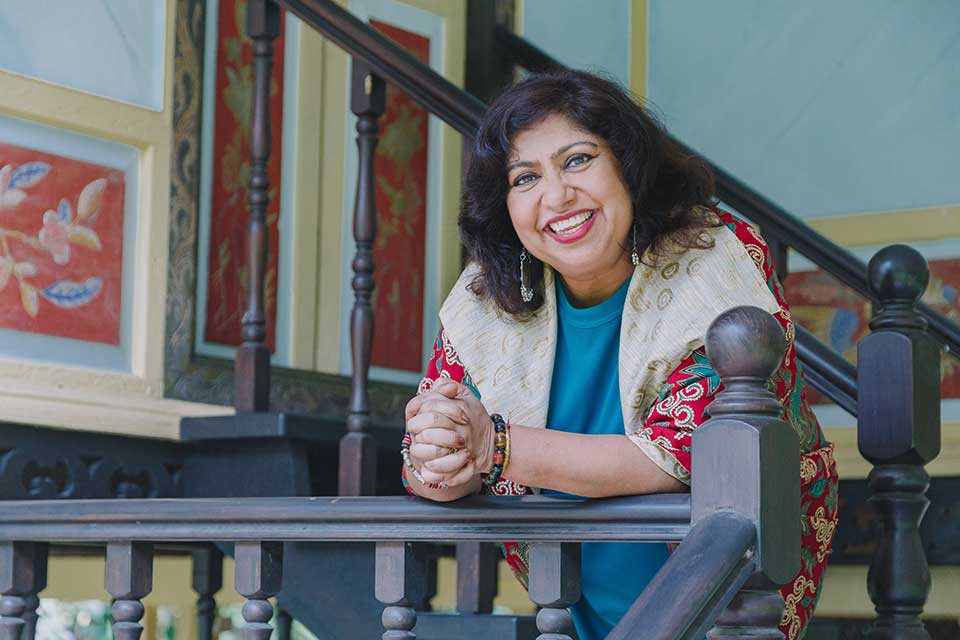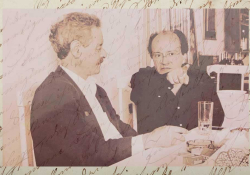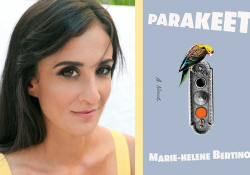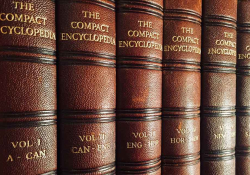Five Weeks in Rimbun Dahan

A writer travels from Chicago to a residency in rural Malaysia, where part of her novel-in-progress is set. While encountering the many living creatures who surround her and making progress on her work, she participates in the local literary scene, catching a glimpse of a possible New Malaysia.
“Are you sure you are not a serial killer?”
The Grab driver is joking, of course. He is driving me back to my cottage—Rumah Balai—set within the dense foliage of Rimbun Dahan, where I am the writer-in-residence for five weeks. I have come from my home in Chicago to work on my novel in rural Malaysia, where part of the novel is set.
Tonight is a cloudy night, and the solar lights along the way are completely dark; there is no illumination at all. Our cottages are not air-conditioned, water is recirculated, everyone is encouraged to create compost for the herb gardens from the food we consume, but even the eco-warrior in me understands how driving on an untarred road by the light of car headlights can make grown men a little nervous.
During the ride from Kuala Lumpur, we have discovered that he has the same last name as a deceased journalist married to my distant uncle in the Bengali community. It never ceases to astonish me that no matter where in the world I am, the enormous Klang Valley operates as a village, and a link to community can always—always!—be found. We feel like family, and have spent the journey discussing the Grab driver’s sixteen-year-old daughter who wants to study creative writing at the Nottingham campus. He worries she will never make money from writing. He is actively dissuading her from her dreams. I have been mentoring Malaysian writers for over two decades, and I know the sad realities of the profession; I have said nothing in her defense.
It never ceases to astonish me that no matter where in the world I am, the enormous Klang Valley operates as a village, and a link to community can always—always!—be found.
Suddenly, like a glowing white mirage, Rumah Balai is framed in his headlights. Rumah Uda Manap and Rumah Penang, the two other historical buildings lovingly restored to their former glory, tower like monuments in the darkness. The headlights catch the glints of the flowering trellis in the frosted windowpanes as the light of the moon starts to shine dimly through the clouds.
“Waaaah!” says the driver. “You live here?”
I nod.
“How much is the cost, ah?”
I tell him that I have been awarded a residency, and it costs me nothing. I open my front door while he waits. His eyes are still open in wonder when he asks if he can see inside.
Much later, I’ll think how stupid it is to invite an unknown male inside, no matter how many acquaintances we have in common—I am still a lone woman. But as the lights from the antique lampholders flood the house, I just open the door wider and invite him in.
The intricately carved four-poster bed with the princess mosquito net, the Chinese cupboard with the frolicking phoenixes, the picturesque kitchen with the enamel mugs . . . he takes it all in.
“I had a Russian passenger once who told me that in Russia, writers are treated like royalty,” he says. He gives me a megawatt grin before he turns to leave. “I think my daughter should become a writer!”
I stand on the balcony, grinning happily, as much for me as for his daughter, as the red backlights are swallowed into the forest again. One of the many cicaks sounds thik-thik-thik over my head; in Bengali, it is saying truth-truth-truth.
* * *
Rimbun Dahan is the home of the architect Hijjas Kasturi and his wife, Angela, and is set on fourteen acres, about a half-hour drive from Kuala Lumpur. It is a world of international artists and dancers and painters and sculptors and poets and writers . . . all developing traditional and contemporary art forms. There are multiple artist studios, a dance studio, an air-conditioned artists’ lounge, and library with spotty internet. There is a remarkable underground art gallery. We are free to forage in the extensive herb garden for aloe vera and curry leaves. In a corner of the herb garden I find the Proiphys amboinensis from the family Amaryllidaceae, which the Malays know as sepenoh; not only do the applied leaves reduce swelling, but the plant is also used to fend off the ghostly pontianaks and hantus from entering a new home.
Unfortunately, nothing fends off the mosquitos. Not even the industrial-strength repellent we all have on as we sit poolside during the orientation, where I meet the other residents for the first time. We all slap ourselves periodically.
Angela Hijjas looks at my bare legs and smiles. I have the same indulgent look on my face when Pan, our Belgian Greek horticultural intern, shows up on his first day in shorts. We all learn, rather quickly, that the organic stuff is useless, and it is the industrial-strength deet-level stuff that is any deterrent.
I meet the other residents—Ruth Marbun, Ajim Juxta, Syarifah Nadhirah—about four days into my residency. During this time, I have tried to figure out the slithery night noises as I awaken from sleep, swept reptile droppings from kitchen cabinets and floors, and learnt to close my windows so that the resident monkey patriarch wouldn’t perch on my windowsill feasting on insects and eyeing me (until I charged at it with my umbrella like a demented Mary Poppins).
Ajim, a Malaysian artist, grew up in rustic surroundings, and Rimbun Dahan does not faze him at all. The Indonesian artist, Ruth, speaks with affection about the large monitor lizards by the pool. Then Nadhirah, Dee, tells the story of a family of bats invading her room in the evening, heading straight for the electrical fan and lying, wounded and bleeding, on her floor. Dee called the caretaker, weeping.
I take a swig of my gin and tonic. This is going to be a long five weeks ahead.
* * *
Dee, at twenty-five, is the youngest in the group but insists on walking with me back to Rumah Balai. I, the newbie, have ventured out without a torch or a phone light and planned a trudge in the dark. She and Ajim both walk me back so that no one walks alone. This is the best part of a residency, the bonds that grow and last through the years, because we all create things from the figments of our imagination, things of beauty and courage and conviction which may or may not reach other people . . . and what we do is so inexplicable to the more pragmatic.
With the dry leaves rustling under our feet, Dee asks, hesitantly, whether she can introduce me to her boyfriend, a social activist and writer, who is familiar with my work. As always, this takes me by surprise; in no other country, especially not in the US, where I now live, do I have such name recognition. It is delicious to hand a credit card for payment in a bookshop in Petaling Jaya and have the cashier gush about a short story, and once a young fan actually did a little jig of joy before talking selfies.
The Impostor Syndrome is real for every writer I know, but it has softer edges, and a ductile embrace—at least for me—in Malaysia.
I feel such a close connection to the writing community in Malaysia that although I understand why writers want to be published and known in English-speaking countries—that is certainly where the money is, if at all—I also hope that they speak to the communities they write for. Frequently in my hometown, Chicago, I wonder whether I am the lone Diversity and Inclusion author in an otherwise homogenous panel. The Impostor Syndrome is real for every writer I know, but it has softer edges, and a ductile embrace—at least for me—in Malaysia.
* * *
Two weeks pass by. I wake up to yoga mornings on a balcony shimmering with sunlight sieved through trees. There is the golden glint of spiderwebs, each day a new thread, or one broken, the pattern renewing. The sapling that I anchor my tree pose on starts sprouting pinkish-red shoots at the base as well as on the branch edges.
Kuala Lumpur is still choked with a haze, but here the mornings are fresh and the evenings cleansed by rain.
I get into a pattern of writing through nights, eating at the Warung Selera Ria across the street, and occasional forays into town. Rimbun Dahan is surrounded by a Malay community, traditional in their dressing, and I see no one who looks like me for days. There is a soft, gentle rhythm to the days, and the four resident dogs—Tambi, Betty, Sago, and Susu—occasionally come and sun themselves nearby. I learn to differentiate between the sharp swing of a monkey and the ponderous passage of a monitor lizard. I grow used to the bolt of the striated cicak resident behind the carved fusebox; I stop looking for movements under my pillow at night.
I buy a radio because it is too quiet. I tell friends I am writing a Malaysian dystopia by plagiarizing news bulletins.
The words come. I publish an article in a newspaper, have another short story accepted. Shorter pieces flow, but my novel feels like wrestling a crocodile; just when I have quietened the fangs, the tail rears up and disables my flow.
This is my third novel, so I know better than to despair. I am patient in the cyclical rhythms of Rimbun Dahan. I buy a radio because it is too quiet. I tell friends I am writing a Malaysian dystopia by plagiarizing news bulletins.
* * *
On March 16, it is Open Day at Rimbun Dahan. Artists are not required to do outreach activities, but I run an ekphrasis workshop to generate writing based on the artwork available at the underground gallery. It is both a challenge and a delight working with Malaysian writers, and for this workshop, I have an Iranian writer and a Syrian poet enrolled.
We start by looking at the whimsical works of Fuad Osman. Like the artist, the writers put themselves into historical Malaya, time-travelling to unpack roots and structures. We all crowd around Helen Crawford’s Reflection; from a distance, the upside-down figure is reminiscent of a lynching, but as you stand around the mirrored bottom, it is the man who is upright, and our images distorted. The participants write furiously about belonging, racism, bullying, inclusivity. Their words are raw and powerful.
Four of the participants—V. S. Lai, Deborah Augustin, Mohammad Amin Kamranimashhadi, Mwaffaq Al-Hajjar—read at Seksan in Bangsar on March 30, in Malaysia’s longest-running monthly reading event curated by Sharon Bakar, an event that has been ongoing for fourteen years. Amin reads from the piece that grew out of the prompt to speak of historical Malaya or a historical homeland; his words take us back to a destroyed Iran:
It’s chaos.
I know you always wanted peace and didn’t care that much who was ruling this cursed land. “After all, they are all the same, we are what matter the most.” I remember you telling me this. As disorganized as everything in my life always has been, you always thought that I like these chaotic situations. That this was the reason that I was excited about the street protests and demonstrations. Yes, I wanted a chaotic situation because I hated all the establishments. But there was one routine that I didn’t want to lose and that was seeing you in the bookstore.
And now I hate this chaos.
Yes, Rimbun Dahan is inspiring; certainly, the gallery is worth getting lost in for a few hours. It also creates a space where inchoate artistic communities are fostered before they move on to public spheres with confidence and skill.
* * *
Being so close to Kuala Lumpur is both exciting and distracting. I read a Bengali poem by Mallika Sengupta (translated by Amit Mukerjee) at Lit Books for World Poetry Day. The event is organized by Pusaka, and Pauline Fan invites fourteen poets to “The Noise of Time,” an evening of poetry in eleven languages (Malay, English, Bengali, Mandarin, Arabic, Persian, German, French, Spanish, Malayalam, and Russian, with translations into English).
There is the launch for The Principal Girl: Feminist Tales from Southeast Asia, a collection of necessary stories from Malaysia and beyond in one beautifully curated collection by Sharifah Aishah Osman and Tutu Dutta.
Commonwealth Writers hosts a panel on the legacy of indenture in contemporary times. It is a thought-provoking panel about erasures and interpretations and ends with a powerful poetry performance by Melizarani T. Selva, who exceeds all expectations.
A poetry evening in Intunnation is incandescent with the voices of spoken-word poets who use cursed myths of Mahsuri and Gunung Ledang to describe the travails of mothers of LGBTQ children. There is a simultaneous poetry translation from English to Malay. The wordsmiths are bilingual and bidialectal, play with multiplicity of cultures and the singularity of taboos. They contain multitudes.
Malaysia is exciting for artists for precisely this reason: there are real problems to open dialogues about, and the magic realists and the fabulists and the fantasists are coming up with ways to express the forbidden.
Dee and I go to a talk hosted by Sisters in Islam about Muslims and the media. The Q&A session is engaged and electric, sometimes bordering on the forbidden, for too many things are still seditious in the country. Malaysia is exciting for artists for precisely this reason: there are real problems to open dialogues about, and the magic realists and the fabulists and the fantasists are coming up with ways to express the forbidden.
Dee, and other Malaysian artists like her, give me hope for a New Malaysia. She is an entrepreneur with her own company but is also engaged in social activism. At Rimbun Dahan, she is an artist, creating a series of exquisite botanic prints to honour our shared ecological legacy.
* * *
Southeast Asian artists can only stay in Malaysia for a month at a time, so Ruth, the Indonesian artist, leaves first. We go for a farewell lunch at a place where we sit on the floor of raised huts and eat with our hands, drinking coconut water out of small tin pails.
Ruth tells me that what she has found the most inspiring about Rimbun Dahan is the trust implicit in the venue. That this is Angela and Hijjas’s home, yet the international artists are instantly made welcome on the grounds, sometimes stumbling upon the couple having a meal, or just strolling in the grounds. The gates are unlocked because the guard dogs are fierce, and we all roam free within the grounds, not as formal guests in someone’s home but creative artists free to produce whatever we choose, without being obliged to share it in any way.
And indeed, Angela is the person I call—because it is her home after all—when I see a rat in my bathroom. She comes at once, with the rat-dispensing dog in tow, the furry Betty who looks more placid than she is. Angela’s whistle summons all the dogs, but it is Betty who races into my bathroom, sniffs around the sandalwood soap that the rodents have chewed through, but finds nothing. Lubis is the grounds man who handles dead bats and live rats, and he is summoned to lay a number of traps.
When I return from a weekend in Kuala Lumpur, they have caught three rats, which are now dead. I am strangely saddened:
by Fady Joudah
My daughter
wouldn’t hurt a spider
That had nested
Between her bicycle handles
For two weeks
She waited
Until it left of its own accord
If you tear down the web I said
It will simply know
This isn’t a place to call home
And you’d get to go biking
She said that’s how others
Become refugees isn’t it?
I am the intruder in Rimbun Dahan, within a habitat that will continue long after I am gone. It teaches me empathy when a young wild boar circumambulates the house looking for an open gate to get out. I back away slowly when it pauses eight feet away, staring at me. It squeals in distress; it has no tusks and looks like a young one separated from the pack. Angela and I sit on the balcony sipping tea and watching him lope around, then she gets up and opens the gates, which are usually locked, so that he can find multiple exits.
Ruby Subramaniam, a visual artist who stayed at Balai Rumah during her artistic residency in 2018, asks me whether I have felt the magic of this place. To her, the ground seemed so hallowed that she took long walks by the light of the moon, communing with all the living creatures around her.
* * *
So how did Rimbun Dahan begin?
Dr. Mahathir was the prime minister when the idea of Rimbun Dahan as an artists’ residency first started to germinate; the Australian prime minister had called Dr. Mahathir “recalcitrant,” and the relationship between Australia and Malaysia was especially fraught. The Kasturis had strong connections to both countries and figured that an artistic bridge could help in healing the political rift. An artistic exchange was initiated between Australian visual artists and Malaysian counterparts, which, over the past twenty years, has developed into a program that encompasses creative aspirants from all over the world.
What the Kasturis have created is a shining beacon in a region where funding for the arts is absent or racially divisive.
* * *
The Grab car drivers all know the legendary architect of Malaysia Hijjas Kasturi, but they talk far more about Bilqis, his daughter. In 2015 Bilqis dropped protest-yellow balloons containing the words “democracy,” “free media,” and “justice” into a function attended by the former prime minister, Datuk Seri Najib Tun Razak. (Datuk Najib’s political party, in power for the last sixty years, was unseated in the Malaysian elections of 2018, and he is now being tried for corruption, including money laundering involving Hollywood celebrities.)
“She is like a hero. You know, like that Tiananmen Square, that fellow that stood in front of the tank?”
He sees my disbelief in the rearview mirror.
“Okay lah, maybe not on the same scale, but you know what I mean . . . we all talk-talk only, but she did something.”
Rimbun Dahan will continue feeding the soul of this nation.
I finally meet Bilqis when she pulls up to Rimbun Dahan in an unapologetically bright yellow car. We chat briefly, about dance and writing and Rimbun Dahan. I will leave this arts sanctuary in a few days, but I feel assured that the legacy of Rimbun Dahan will live on for years to come, allowing many more artists to create and affecting our communities in many subtle ways. This place will continue feeding the soul of this nation.
There is a new gamelan troupe that is setting up its equipment now. The two master craftsmen from Bali tap at the instruments to tune them, while the group from Kuala Lumpur watches and learns. Tap-tap. A bird chirrups in response. The melody melds into the breeze.
Chicago
Editorial note: This essay was first published in The Edge on April 29, 2019.











